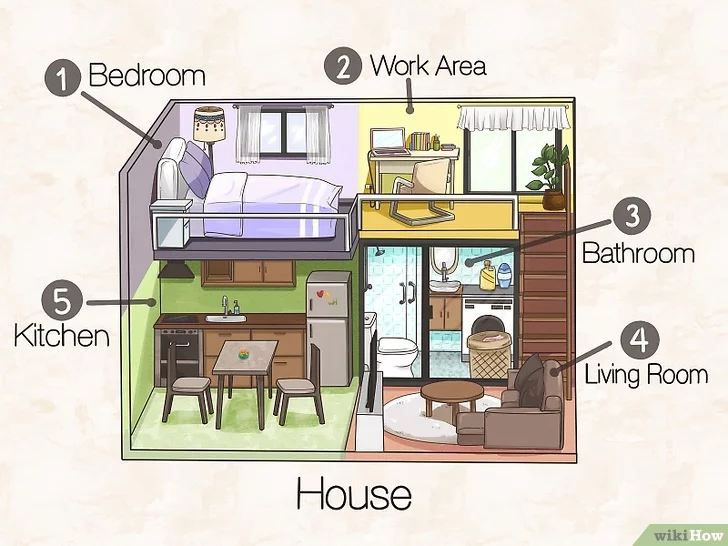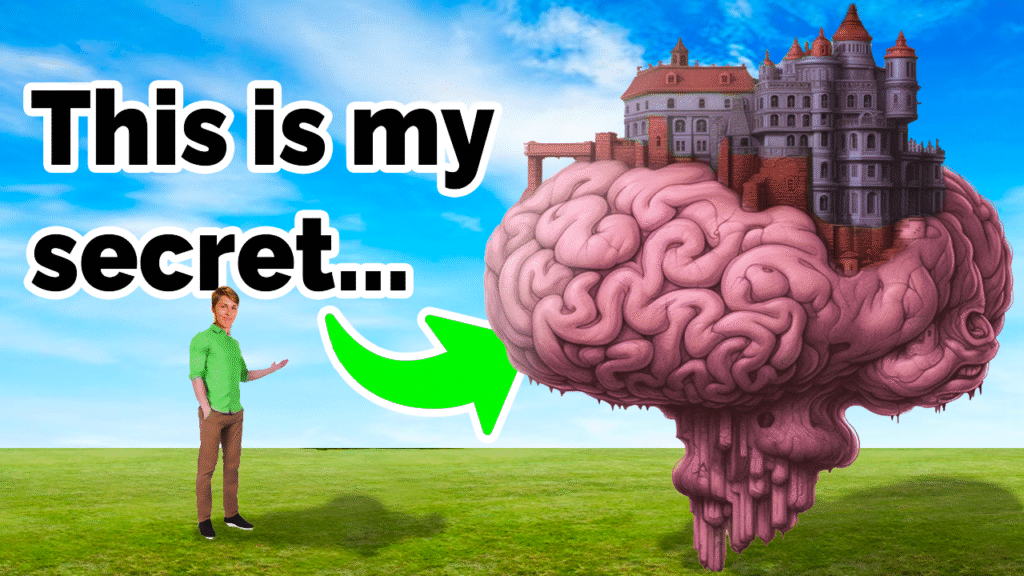A memory palaces is just a mental map of a physical place you know really well. Like your childhood home. Or your favorite cafe. Or even that weird grocery store that plays 2000s rock on repeat.
The trick? You place the info you want to remember inside this space—mentally, of course.
You don’t walk into Starbucks sticking Post-it notes on the espresso machine. You imagine it.
My First Attempt Using Memory Palaces: Memorizing the Periodic Table (Why?!)

Okay, so during a weekend of nerdy self-inflicted torture (or “self-improvement” as I tried to frame it), I thought it would be cool to memorize the periodic table.
I’d tried before—failed miserably. But this time, I built my memory palace.
My location of choice? My grandmother’s house. The one with the creaky steps, the strange smell of cardamom, and the old iron trunk with family photos.
I placed:
- Hydrogen as a floating bubble at the main gate
- Helium as a balloon in the front yard
- Lithium as a battery sizzling on the coffee table
- Sodium dancing with Salt Bae in the kitchen
I made every element weird, funny, or absurd. Suddenly, these abstract names had stories. Places. Visuals.
It was like turning a boring list into a sitcom.
Why Memory Palaces Work (At Least for My Brain)
There’s real brain science behind this.
Our brains evolved to remember places—like where that berry bush was, or which cave had bears inside.
Visual + spatial memory is ridiculously strong.
So when you attach facts to spaces you already know, your brain doesn’t have to try so hard. It just retrieves.
Think about it—how many times have you forgotten your to-do list but still remember the layout of your childhood home perfectly?
It’s kind of like hacking your brain with its own wiring.
But Are Memory Palaces Only for Nerd Stuff?
Not at all. Once I got the hang of it, I started using memory palaces for random, everyday things:
- Grocery lists (seriously, put “eggs” in your bathroom sink and “bread” on your pillow)
- Presentations at work (I mentally walk through a building—each room has a slide’s main point)
- Names of new teammates (each name gets dropped into a “desk” in my mental office)
It feels like mental file cabinets that you just open with a walk-through.
The Silly Secret Sauce: Make It Weird
Here’s what surprised me: the weirder the image, the better it sticks.
Like, don’t just place “Mercury” on a table. Make Mercury a sweaty guy in a racing suit eating noodles on your dining chair. That mental image? It won’t leave.
In fact, the more inappropriate, silly, or dramatic the image is, the more your brain goes:
“Oh heck yes, I’ll remember that forever.”
Sounds ridiculous. That’s the point.
The Downsides (Because Nothing’s Perfect, Right?)
Okay, a quick dose of honesty.
- Memory palaces take a bit of setup time.
The first time you try it, it might feel clunky—like organizing sticky notes inside your head while someone’s yelling at you to be faster. - You can’t use the same palace over and over unless you “clear it out.”
So I’ve now mentally decorated a bunch of familiar places: my school, my hostel, the walking trail near my apartment. - One day, I even tried using my own body as a palace. (Spoiler: it worked.)
So yeah—effective? Yes. But not totally effortless.
A Strange Side Effect: Mindfulness
This is going to sound woo-woo, but creating and walking through memory palaces made me a bit more… present?
Like, when I built my old college campus as a palace, I started feeling those old memories again.
The smells. The corridor echoes. That one broken bench.
It’s like doing memory work doubled as emotional reflection. So weird. So real.
Who’s Using This? (Not Just Me)
Turns out, memory champions—yeah, there’s a whole sport for that—live by this method.
They memorize:
- Decks of cards
- Long strings of numbers
- Poems and scripts
Some actors use it for learning lines. Some polyglots use it for vocab.
There’s even a guy on YouTube who remembers Pi to thousands of digits by placing them in a virtual town.
You don’t have to go that far. But it proves this stuff isn’t just theory.
It’s practice.
My Favorite Quick Tip: The Mental Walk-Through
When I really need to retain something—like talking points for an interview—I just take a quiet minute before and mentally walk through my palace.
It’s weirdly calming.
Like muscle memory, but for thoughts.
And it almost always works.
Final thought
Look, I’m not some guru or memory wizard. I forget birthdays. I leave water bottles behind. I still Google things I should remember.
But using memory palaces made learning and keeping information way less stressful.
It turned memorization into play. Into imagination.
And in a world where everything’s just a search away, it feels cool to know something by heart.
To not need to pull out a phone for every little thing.
If you’ve ever struggled with remembering, try it. Start small. Use your room. Your walk to work. Your daily coffee spot.
Throw a few crazy, funny, vivid facts in there.
Read our more blogs-DIY Smart Lock Project with ESP8266 Wi-Fi Module


